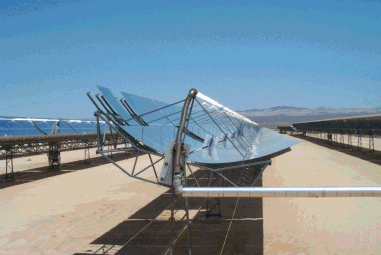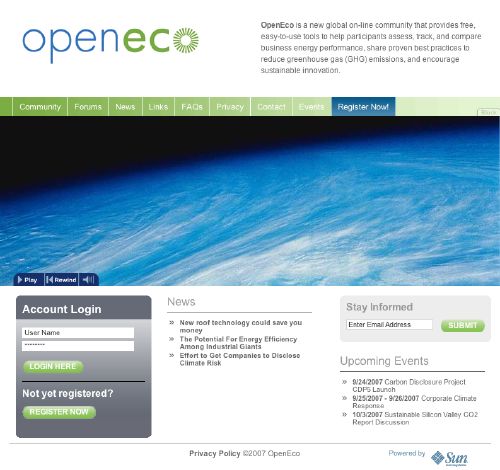Archive for September, 2007
$1.5B for Solar Thermal

Via Renewable Energy Access:
Comments are off for this postFPL Group Incorporated, a generator of renewable electric power, yesterday announced a $2.4 billion investment program aimed at increasing U.S. solar thermal energy output and reducing carbon dioxide emissions that contribute to global warming.
“These new investments, coupled with our recent announcement to invest an estimated $20 billion in new wind generation, demonstrate FPL Group’s continued commitment to improve the environment.”
–Lew Hay, Chairman and CEO, FPL Group.
The majority of the investment ($1.5 billion) will go in new solar thermal generating facilities in Florida and California over the next seven years, starting with a project at FPL. FPL is planning to build 300 megawatts (MW) of solar generating capacity in Florida using Ausra, Inc.’s solar thermal technology.
US Geothermal ups PPA by 30%

Recently, US Geothermal renegotiated its power purchase agreement with the Idaho Power Company increasing it from 10MW to 13MW. Details are available in this press release. This constitutes the first segment in what is believed to be a 45.5MW project at Raft River, Idaho. This is good news for the company as it shows that the project will have greater net output than originally forecast. Comments are off for this post
Decision Time: Energy Investments
Recently, one of our partners brought an interesting situation to light. AMP-Ohio, a US electricity generation company, is working to build a new $2.7B, 1,000MW “clean coal” generation facility on the Ohio River. As part of the planning for this plant, the company is visiting the municipalities it serves and asking each for a 50 year commitment in the form of a power purchase agreement to aid in lining up the financing for the project. None of this is news, it’s happening every day across the country for every type of project.
The interesting bits of this story revolve around the tactics being employed by AMP to secure the commitments from the municipalities and ultimately, the choice these municipalities have in determining our energy future and policies.
A municipality involved in this is Yellow Springs, Ohio. A village of some 4,000 people located in southwestern Ohio. Historically, the village has been an independent where electricity is concerned, opting out of the large investor-owned utility Dayton Power and Light (now a subsidiary of DPLInc.) to maintain control over power production and distribution. AMP has created a sense of urgency around the project asking the municipalities to commit within a six month time frame or risk losing their AMP electrical supply when the current power purchase agreements expire in a few years. The leaders of the community are not experts on electricity generation and distribution (though there is expertise in the village staff and advisors) and are feeling the heat. In addition to the AMP proposal, the village is also struggling with issues around electricity distribution, but this is a separate issue from power supply.
As this topic heats up, there are editorials appearing and offers from groups like the National Resources Defense Council to come work with the village to understand its choices. This scene must be playing out in hundreds, if not thousands, of communities across the country. It comes down to a very real choice about how to proceed in the future: Why should communities invest in new fossil fuel projects with known negative impacts? Why not explore, and ultimately invest in, more reasonable and sustainable approaches? At $2.7M per megawatt of generation capacity in the proposed plant, why not look at resources like geothermal with the same baseload characteristics of a coal plant, and virtually none of the emissions? Averaged development cost per megawatt? $3M.
In a note written to the our partner who happens to reside in this village yesterday, some questions were posed that the village leadership should be considering:
- Has the village characterized its resource requirements/load? Has this been projected into the future?
- What is the net present value of the village’s aggregate power purchasing over a 50 year horizon?
- What conservation programs have been contemplated to affect the load over the longterm?
- What local renewable resources have been reviewed for feasibility of serving the electrical load?
Armed with this information, a community dialogue can then begin around the available choices and informed decisions based on information can be made. From a personal perspective, the simple act of installing compact fluorescent lamps in 87% of a home’s light fixtures has reduced electricity demand by 25%. That’s hard data, a story about it is available here. Small choices like this made across a community can have a large impact.
Regardless of where one stands on the environmental issues like global warming, green house gases, particulate air pollution, acid rain, etc. it is the country’s economic interest to not direct one more dollar toward development of new fossil fuel electricity generation. Now is the time, with each of these sorts of decisions at the local level, to assert our desire to responsibly and reasonably harvest renewable resources for our future power needs. This should be coupled with demand management and simple and effective conservation mechanisms that require minimal impact on end consumers. In this way, we can shape a better future for our families and minimize our negative impact on our environment.
Where does your community get electrical power? Are there decisions being taken by your local government? Now would be a good time to find out and make your voice heard. If people don’t speak out on these issues, the situation will not change.
PHEV: Groundswell?

An interesting trend seems to be taking hold around vehicles like Toyota’s Prius, home-grown conversions from standard hybrid to plugin hybrid by adding battery power, a charger, and socket to plug the vehicle in for charging. The magazine GreenCar.com has an interesting article about this phenomena. It would seem that the public is going to drag the automakers along on this one (along with a little pressure from the likes of Google.)
What’s the attraction? 120+ MPG. Imagine getting over 1,100 miles on a single tank of gas. Watch the video below:
OpenEco.org

A leading technology company, Sun Microsystems, has released a community-based carbon footprint tracker today called OpenEco.org. It’s clearly just a start, but it’s interesting in that the point is to have folks measure their activity, set goals for improvement, and track them on the website. The theory is, if you can see it, then you can do something about it. Since there is a community involved, best practices can be formed and shared across the community.
Sun has proved masterful at building communities throughout its 25 year history, but this is a slightly different animal. It’s encouraging to see a large company step up and sponsor this, but I have to wonder, who will participate? The price of participation is high – that being the entry of vast quantities of data into the system. Yes, the community participant can choose how much is private vs. public, but just the act of entry is a high price. And it’s not a one-time gig. If Sun and the community can find a way to ease this price, then there may be some community growth.
But, this much is true, if you can’t see it, you won’t do anything about it. We applaud the company for making the effort. Comments are off for this post








